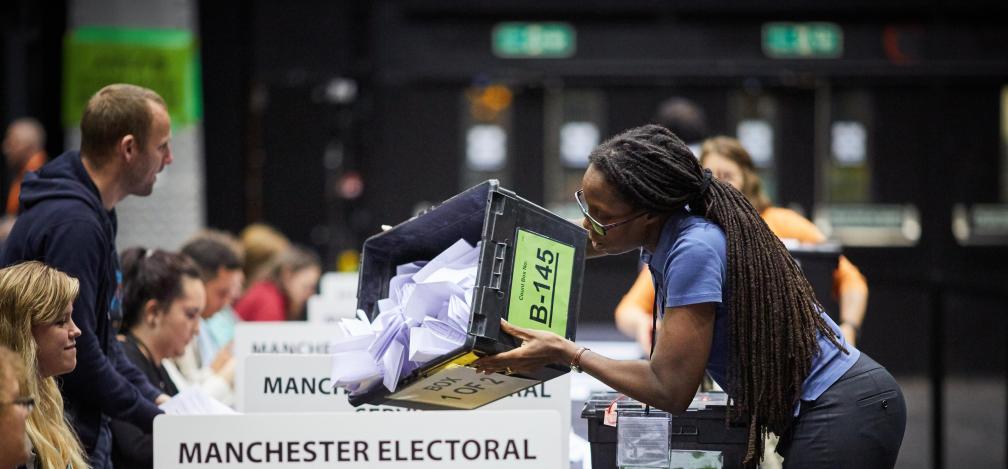Local elections 2024: Mayor of Liverpool City Region
Voters in Liverpool and five neighbouring boroughs will elect the mayor of Liverpool City Region.

On 2 May 2024, Steve Rotheram was elected for the third time as mayor of Liverpool City Region winning a total of 68% of the vote. Rotheram leads the Liverpool City Region Combined Authority, which is formed of Liverpool and five neighbouring boroughs
What was the result of the 2024 mayor of Liverpool City Region election?
Steve Rotheram was the winner of the May 2024 Liverpool City Region mayoral election. He represents the Labour Party and was previously elected to the post in May 2017 and May 2021. Rotheram was formerly MP for Liverpool Walton.
The turnout across the region was 24%, lower than the 2021 election where turnout was 30%
The 2024 Conservative party candidate was Jade Marsden, who previously stood against Rotheram in the 2021 mayoral election, who received 10% of votes. Further candidates included the Liberal Democrat’s Rob McAllister-Bell and the Green Party’s candidate Tom Crone, both of whom are councillors, as well as independent candidate Ian Smith.
What is the history of devolution to the Liverpool City Region?
The six councils in the Liverpool metropolitan area formed Liverpool City Region Combined Authority (LCRCA) in 2014. It was established as a legal entity in April 2014 using powers under the Local Democracy, Economic Development and Construction Act 2009. As a combined authority, it has the ability to take certain collective decisions and exercise delegated functions that cross council boundaries.
In November 2015, a ‘devolution deal’ was reached between the UK government and the LCRCA, which involved the creation of the new post of ‘metro mayor’, who would become chair of the combined authority. This deal led to the transfer of functions from Whitehall, including over transport, planning, skills and investment, and the first election took place in 2017.
What is the Liverpool City Region Combined Authority?
The LCRCA has eight members, including the metro mayor - who chairs the authority - and the leaders of the six constituent local authorities: Halton, Knowsley, Liverpool City, Sefton, St Helens, and Wirral. The eighth member, who has no voting rights, is a representative of the Business and Enterprise Board.
The Merseyside police and crime commissioner and the chair of Merseytravel, the transport executive for the region, have also both been co-opted as non-voting members. Warrington and West Lancashire borough councils are non-voting associate members.
The total population of the area covered by the LCRCA is 1.6 million.
The Labour Party currently has majority control of five of the six constituent local authorities in the LCRCA. The exception is Wirral, which is Labour-led but has been under no overall control since the party lost its majority in 2019. 16 BBC ‘Election results: Labour loses overall control of Wirral Council’, BBC, 3 May 2019, retrieved 6 December 2021, www.bbc.co.uk/news/uk-england-merseyside-48143814
Local and mayoral elections 2024
On Thursday 2 May, voters across England and Wales will head to the polls in a major set of mayoral and local elections. Keep up with our latest content, events and analysis on why these elections matter and the results when they come.
Find out more
What are the powers of the Liverpool City Region mayor and combined authority?
The powers and responsibilities of the LCRCA and metro mayor are focused on economic functions, including transport, planning, regeneration and skills.
The mayor and combined authority have control of a devolved transport budget and associated transport powers. The LCRCA recently announced plans for bus franchising as part of a wider vision to create a ‘London style’ transport system. 22 Gwyn Topham, ‘Liverpool announces it ill bring buses back under public control’, The Guardian, 6 October 2023, retrieved 22 February 2024, www.theguardian.com/uk-news/2023/oct/06/liverpool-announces-it-will-bring-buses-back-under-public-control Transport powers have also been used to provide discounted travel to groups such as apprentices.
Since August 2019, the LCRCA has been responsible for the 19+ adult education budget, enabling it to develop a skills strategy that fits the needs of the local labour market.
The mayor and combined authority have a devolved investment fund, which it uses to finance infrastructure projects such as an ultrafast broadband network spanning the Liverpool City Region. The mayor also has powers over regeneration including undertaking compulsory purchase orders, with the consent of the local authority in which the site to be purchased is situated.
The mayor is empowered to develop a statutory spatial development strategy for the region, with the unanimous agreement of all the local councils. A draft SDS was published in late 2023. 23 LCRCA, Towards a Spatial Development Strategy for the Liverpool City Region up to 2040, November 2023, retrieved 25 March 2024, https://api.liverpoolcityregion-ca.gov.uk/wp-content/uploads/2023/12/735-LCRCA-Spatial-Development-Strategy-V11-ACCESSIBLE.pdf For planning applications of ‘strategic importance’ to the region, the combined authority can take on the role of local planning authority. Lastly, the mayor proposes a budget and transport plan for the combined authority, subject to agreement by the combined authority as a whole.
What is the LCRCA’s budget?
IIn 2022/23 the Liverpool City Region spent £633m on services. 24 https://api.liverpoolcityregion-ca.gov.uk/wp-content/uploads/2023/09/LCRCA-Statement-of-Accounts-2022-23-Subject-to-Audit.pdf A majority of this spending (£348m – 55% of the total) was allocated to the ‘Place’ directorate that is responsible for the region’s large transport budgets. A further £176m (27%) of spending took the form of grants made by the LCRCA Strategic Investment Fund, which invests in projects that deliver inclusive growth for the region.
The City Region received over £366m in grant funding towards these costs. 25 https://api.liverpoolcityregion-ca.gov.uk/wp-content/uploads/2023/09/LCRCA-Statement-of-Accounts-2022-23-Subject-to-Audit.pdf Additional sources of funding included almost £8m raised via the mayoral precept and almost £99m raised via the transport levy – a fee paid to the LCRCA by its six constituent members, in proportion to their population. LCRCA ran a £72m deficit in the 2022/23 financial year. 26 https://api.liverpoolcityregion-ca.gov.uk/wp-content/uploads/2023/09/LCRCA-Statement-of-Accounts-2022-23-Subject-to-Audit.pdf
The devolution deal allocated an investment fund worth £900m over 30 years to the LCRCA. This is delivered through annual payments of £30m, subject to five-yearly reviews by the Treasury, the first of which was successfully completed. The payments are not inflation-linked, and so their real value will decline over time. The fund is used to invest in projects to increase regional productivity and growth: 75% of the funding is for capital expenditure and 25% for operations/revenue.
The LCRCA also administers regional capital transport grants, such as money from the Transforming Cities Fund and City Region Sustainable Transport Settlement. Other funding from central government supports devolved delivery of the adult education budget and brownfield housing development.
As of March 2023, the combined authority group (including its transport authority, Merseytravel) employed a total of 962.3 full-time-equivalent staff.
How does the LCRCA compare to the rest of the UK in terms of social and economic outcomes?
The LCRCA region lags behind the UK average in key economic indicators such as gross value-added (GVA) per hour worked and gross median weekly pay. The region also ranks below the UK average in terms of skills and employment.
However, there is significant variation between the constituent local authorities on some metrics, such as GVA, where Halton is above the national average. Use of public transport to get to work is high in Liverpool, but below the UK average in other constituent councils. Similarly, Sefton has a higher male healthy life expectancy than the UK average, but the region as a whole falls below.
The LCRCA region has a whole has a higher average gigabit availability (82%) than the UK average (76%), with only Halton (74%) and Sefton (67%) below that average.
How does the LCRCA area overlap with other administrative boundaries?
LCRCA covers the same geography as the Liverpool City Region LEP, which has been integrated into the combined authority as the Business and Enterprise Board. However, LCRCA intersects in complex ways with other local administrative boundaries.
The LCRCA region is covered by the Cheshire and Merseyside NHS Sustainability and Transformation Partnership (STP), but the STP also includes the non-constituent local authorities of Cheshire East, Warrington and Cheshire West and Chester. STPs bring together local authorities and NHS organisations to facilitate the development of ‘place-based’ approaches to the delivery of NHS services in given regions.
The LCRCA area is not coterminous with a single police force area: Merseyside Police serves Knowsley, Liverpool, Sefton, St. Helens and Wirral, whilst Cheshire Constabulary serves Halton. In 2005/6, there were proposals to merge the Merseyside and Cheshire police forces, however these plans did not progress. 28 BBC, ‘Police merger timescale ‘absurd’’, BBC, 18 November 2005, retrieved 14 December 2021, http://news.bbc.co.uk/1/hi/england/merseyside/4449558.stm Unlike in some other city-regions, the mayor of Liverpool City Region does not hold the position of police and crime commissioner, which the government only allows when the police and mayoral boundaries align.
- Topic
- Devolution
- Position
- Metro mayor
- English Regions
- North West
- Combined authorities
- Liverpool City Region Combined Authority
- Publisher
- Institute for Government